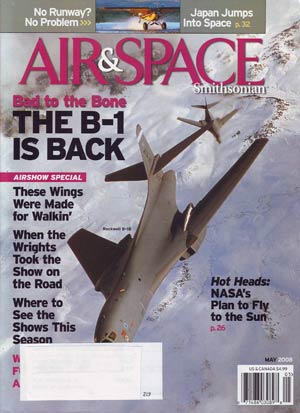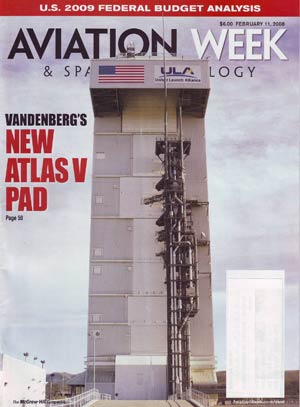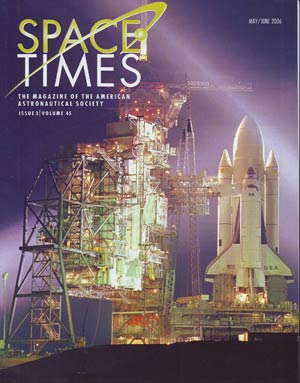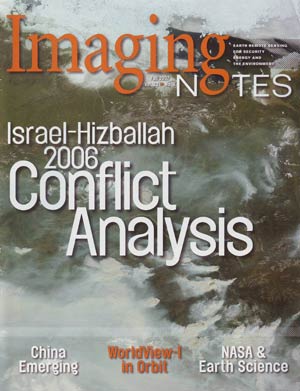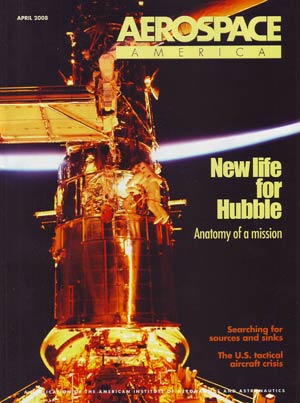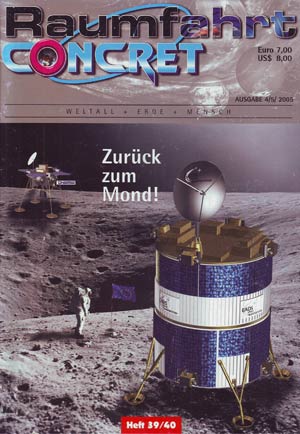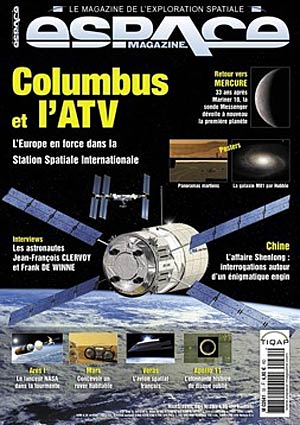A quick guide to space news publications in print
Air & Space One of the best popular aviation magazines in existence, Air & Space has great articles, excellent photographs, and overall high quality. It also has some of the most original covers of any aviation magazine. The layout is clever, although not trendy or overly flashy (see some popular British magazines to see what happens when publications get too overenthusiastic about their layout). Air & Space usually runs about eight feature articles, and no more than two of these are devoted to space topics. The space articles are usually either about history or current plans for human and robotic space missions.
Aviation Week & Space Technology This is considered one of the deans of space reporting and certainly the magazine has been around a long time. In general, space represents only a small portion of the magazine, usually no more than two or three articles out of maybe a couple of dozen in each issue. The quality of coverage varies. American human spaceflight, including shuttle and station, get excellent coverage (pre-launch articles are often 3–4 pages long, and post-flight articles are usually about a page). The launch industry and commercial industry such as communications satellites, are not covered nearly as often, although feature articles do provide good depth on certain subjects. They also include occasional feature articles on non-American spaceflight activities as well. Despite its reputation as “Aviation Leak” for supposedly exposing government secrets, the magazine’s military space coverage is relatively weak. As one prolific intelligence historian has noted, he has never learned a single code-name of a classified satellite system from Aviation Week, and it is clear that they have no special access to the intelligence space program (my own experience reading their articles on the declassified reconnaissance programs confirms this assessment). Every so often they venture into poorly-sourced territory about advanced spacecraft (see: Blackstar). But occasionally they can shine in unusual ways, such as a recent in-depth article about a newly refurbished launch facility at Vandenberg Air Force Base—the kind of story that has not been covered anywhere else. If you are interested in the best combination of current news and in-depth information, this is probably second only to Space News.
One little secret: despite its off-putting subscription price (aimed at business subscribers whom they assume can afford it), the magazine does offer a significantly reduced subscription rate of approximately $46 a year which they use to entice new readers. They then jack up the rate the next year, and will only lower it if you hold out for several months until they try to lure you back. How you get that initial rate is unclear, but you might try haggling with their sales reps over the phone.
Space Times The magazine of the American Astronautical Society. Articles cover a range of spaceflight subjects, usually focusing on recent American human space history and policy issues, with at least one or two pro-space opinion pieces. They commonly reprint policy speeches by senior space officials, such as NASA administrator Mike Griffin. The magazine also features reports on AAS activities and meetings. This is probably the one magazine on this list that I don’t really understand. I’ve never figured out what its primary focus is, and rarely found much worth reading between its covers. A number of their articles are apparently reprinted from other sources, or are summaries of larger works published in other forums—not that there’s anything wrong with that, but it does decrease the amount of original content. Back in the mid-1990s I wrote for them and concluded that they treated their writers poorly and this affected their ability to recruit writers (they don’t pay for articles, and I found that obtaining free copies of issues that I wrote for was like pulling teeth), but I don’t know if that has changed.
Imaging Notes Imaging Notes is probably the most narrowly-focused magazine on this list and definitely a trade magazine, devoted to the commercial remote sensing industry. The focus is not on spacecraft and sensors, but rather how people are using their capabilities. Past issues have featured articles on how the US Army uses commercial satellite imagery, how remote sensing is vital to understanding climate change, and new policies and plans for the remote sensing industry. Imaging Notes is the one magazine on this list that I’ve found consistently surprising over the past couple of years, with articles about how commercial imagery can be used to shed light on international events. For instance, Imaging Notes ran articles that demonstrated how commercial satellite imagery could prove that genocide is being committed in Darfur, how China is modernizing its submarine fleet, and how fighting raged in southern Lebanon. It illustrates how satellite imagery is directly relevant to some of the most pressing issues of the day.
Aerospace America The magazine of the American Institute of Aeronautics and Astronautics. Each issue contains about 2–3 feature articles, roughly equally divided between aviation and space. There are also regular columns, usually about two pages long, with summaries of industry and Washington-related news. The space articles usually focus on subjects related to NASA human and robotic space flight, tend to be technical in nature, and often offer an in-depth discussion of a subject. They are often written by knowledgeable journalists like Leonard David and Frank Sietzen, and are excellent, if rather narrow. Occasionally the magazine features a small history article, but these tend to be superficial. Articles about non-American space programs are unheard of. But the magazine does feature some annual rundowns of the state of international space programs as well as the aerospace industry. Although a monthly and thick, the majority of each issue is devoted to advertising professional courses available to AIAA members and upcoming professional development conferences. See their really cool-looking homepage.
Raumfahrt Concret (Spaceflight) A German publication that is impossible to find in the United States and therefore requires a subscription. The name translates into “Spaceflight” (“Concret” does not mean “concrete” but roughly translates to mean “now” or “actual” emphasizing “Spaceflight”). Although written primarily in German, it frequently features short English-language introductory summaries of the articles. The magazine has nice layout, high-quality paper, and full color photos. RC covers human and robotic spaceflight, with an emphasis on European projects and recent space missions. I will rather sheepishly admit that although I have served as an associate editor for RC (meaning that I write articles for them that somebody with better German skills than I translates for me), I have little knowledge of the quality of the actual articles, because my German is so bad.
Probably the best feature of the magazine is the artist illustrations by Dietmar Röttler. Röttler produces painstakingly accurate images of spacecraft and launch facilities, such as a detailed poster of the shuttle launch pad and cutaways of everything from spy satellites to the Space Shuttle. His work deserves far better exposure than it has received. Many of the other magazines on this list would really improve their look if they used Röttler’s artwork.
Espace I’ll confess that I know almost nothing about this magazine. I studied just enough French in high school to mess up my German (which was never good to begin with) and now the best I can do is recognize words like baguette and les Etats Unis. That said, several people have pointed me to Espace as a top quality publication possibly equal to or better than Spaceflight in the breadth of its coverage and second only to Novosti Kosmonavtiki in overall quality. (The only other notable French publication is Air et Cosmos, which is essentially the French equivalent of Aviation Week & Space Technology.) Espace regularly features interviews with astronauts and cosmonauts and at least one historical article per issue. The thing that distinguishes Espace compared to all the rest is the excellent artwork and the quality of the pictures. One well-versed reader describes it as “probably the glossiest spaceflight magazine around these days.” Paper—not yet ready to foldCompiling this list was rather surprising. There are actually more space magazines than I originally expected to discover. Very few of them are available on newsstands, and several of them come with either expensive subscription fees or society membership dues. If you are an active member of a professional society, or have an employer to cover the costs, then some of these publications will be readily available. But a regular person would find it difficult to subscribe to a number of the trade publications without breaking the bank (for instance, you could spend nearly $300 on Space News and Aviation Week alone). But if you have a thousand dollars to spend on them, you could easily get nearly 200 issues of space-related news a year just by focusing on the American publications (half of that total would be the weeklies Space News and Aviation Week, of course). What that indicates is that despite the Internet, there is still a substantial amount of space information in print form, more than you could ever read. The magazines produced by the professional societies like AIAA and AAS tend to reflect the establishment—i.e. government—space program, centered on NASA human spaceflight, and to a lesser extent robotic civil and military space programs. They also often feature reprinted speeches by government officials. That used to be a service a decade ago, but today all of that stuff is available on the Internet far faster; all the magazines do is elevate these materials for their own audiences. That’s still a service, but it is much less of one today than only a decade ago. Naturally those magazines produced by the space advocacy societies reflect their members’ interests. Entrepreneurial/private spaceflight has been represented by Ad Astra for some years, but is now also covered by Launch as well as more general space magazines like Spaceflight. Still, these magazines only tend to report on the most public aspects of this subject and nobody really digs much deeper into the obscure and fly-by-night entrepreneurial space field. (Sam Dinkin used to interview space entrepreneurs for The Space Review, something that nobody else does in print these days, and is still rare on the net.)
A few subjects are underrepresented, primarily military space and commercial space. However, compared to the web, print is practically the only place that you will regularly find information on these two areas. If you want comprehensive coverage of military space, you really have to subscribe to several publications with high price tags (such as Space News, Aerospace America, and Aviation Week). Only Space News performs what could be considered investigative journalism—digging up information that the government does not want exposed. It is rare that any of these publications will dig up information that corporations do not want exposed, and those issues usually only make news when the companies admit that they have problems, or when their rockets blow up. Which brings up one of the overall weaknesses of virtually all of these publications: in some way they are beholden to the industry as a whole and do not want to create too many waves. Publishers do not want to run articles that will anger NASA, the Air Force, the National Reconnaissance Office, or Boeing or Lockheed Martin. Doing so could possibly hurt their advertising revenue or their circulation base. But more likely it could hurt their access. This is one of the inherent weaknesses of any trade press. There is another subject area that is, for all intents and purposes, only available in print form: space history. Several of the publications listed above regularly publish space history. You would be hard-pressed to find original space history on the web. So what is going to happen to these publications? Although print may seem anachronistic in this digital age, I’m not ready to write it off for another century or so. After all, movies did not eliminate the theater, television did not eliminate radio, the car did not eliminate the bicycle, and far more men use conventional razor blades than electric razors. Sometimes old technology will persist because it is better for certain niche uses than any modern alternative. Nobody reads a laptop at the beach or the barbershop, or wants to. I don’t see magazines in general folding anytime soon (although print newspapers will vanish before magazines because their information is the most immediate and fleeting). Most of these publications rely much more on subscriptions than on advertizing, and without any insider knowledge of these space publications and their subscription bases, I cannot comment with any confidence about their long-term staying power. My suspicion is that Launch will last the shortest, as it lacks broad exposure and an institutional base (like the NSS, BIS, Planetary Society, ESA or Roskosmos), and it must be expensive to produce. I also would not be surprised to see Quest fold in a few years, because it seems to lack the kind of support from the space history community that it requires in order to stay vibrant. Space News strikes me as the most likely publication to go to an online subscription format, although I don’t expect that to happen for awhile—and I don’t want it to, because I usually read it on the subway, not when I’m at a computer. As for the rest? I predict that most of these will be around for at least a decade or more. I’m certainly not giving up my subscriptions, although I don’t know where I’ll put them. Home |
|

